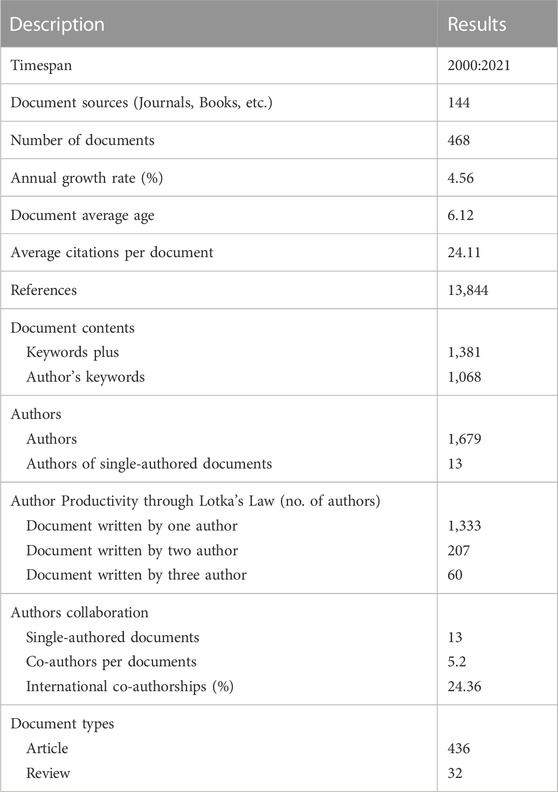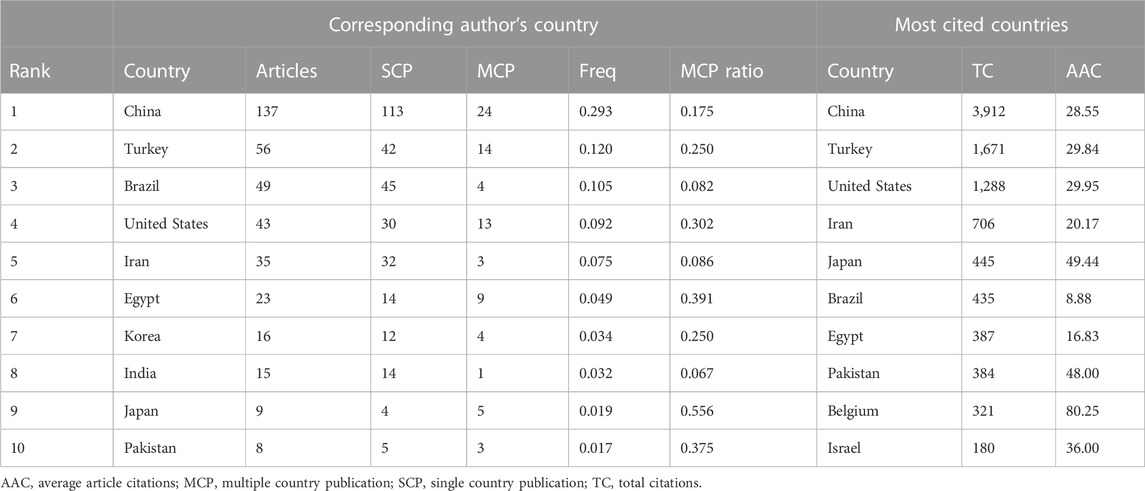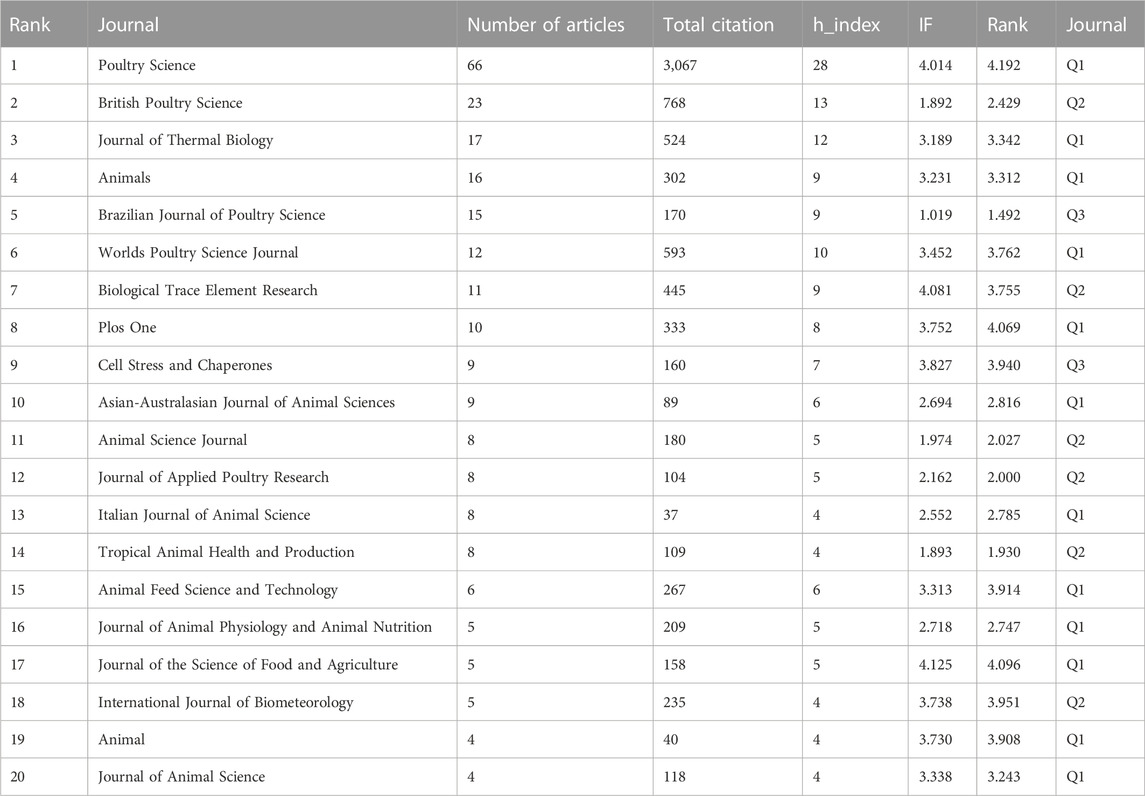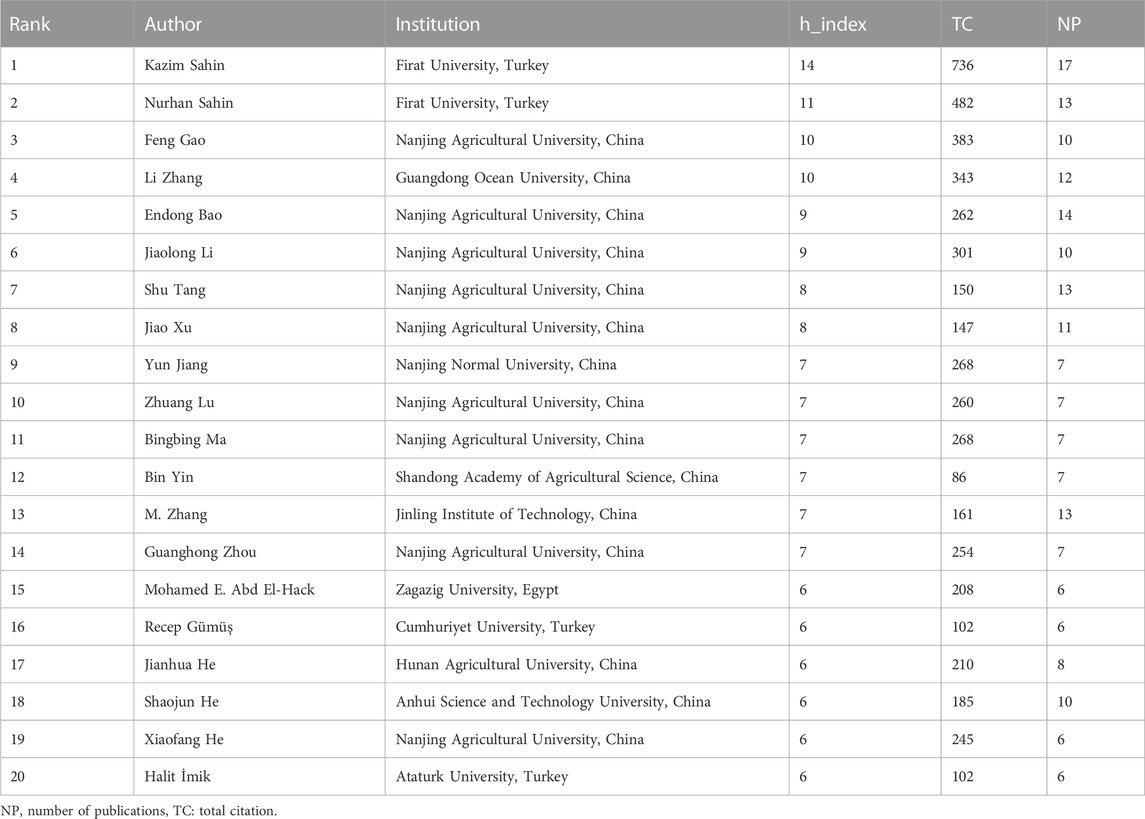- 1Shandong Provincial Key Laboratory of Animal Biotechnology and Disease Control and Prevention, Key Laboratory of Efficient Utilization of Non-Grain Feed Resources (Co-Construction by Ministry and Province), Ministry of Agriculture and Rural Affairs, College of Animal Science and Technology, Shandong Agricultural University, Tai’an, China
- 2Biomedical Research Institute, Darfur University College, Nyala, Sudan
- 3Department of Animal Physiology, Federal University of Agriculture, Abeokuta, Nigeria
Background: Heat stress remains a major environmental factor affecting poultry production. With growing concerns surrounding climate change and its antecedent of global warming, research on heat stress in poultry has gradually gained increased attention. Therefore, this study aimed to examine the current status, identify the research frontiers, and highlight the research trends on heat stress in poultry research using bibliometric analysis.
Methods: The literature search was performed on the Web of Science Core Collection database for documents published from 2000 to 2021. The documents retrieved were analyzed for their publication counts, countries, institutions, keywords, sources, funding, and citation records using the bibliometric app on R software. Network analysis for co-authorship, co-occurrence, citation, co-citation, and bibliographic coupling was visualized using the VOSviewer software.
Results: A total of 468 publications were retrieved, and over the past two decades, there was a gradual increase in the annual number of publications (average growth rate: 4.56%). China had the highest contribution with respect to the number of publications, top contributing authors, collaborations, funding agencies, and institutions. Nanjing Agricultural University, China was the most prolific institution. Kazim Sahin from Firat University, Turkey contributed the highest number of publications and citations to heat stress in poultry research, and Poultry Science was the most productive and the most cited journal. The top 10 globally cited documents mainly focused on the effects of heat stress, alleviation of heat stress, and the association between heat stress and oxidative stress in poultry. All keywords were grouped into six clusters which included studies on “growth performance”, “intestinal morphology”, “heat stress”, “immune response”, “meat quality”, and “oxidative stress” as current research hotspots. In addition, topics such as; “antioxidants”, “microflora”, “intestinal barrier”, “rna-seq”, “animal welfare”, “gene expression”, “probiotics”, “feed restriction”, and “inflammatory pathways” were identified for future research attention.
Conclusion: This bibliometric study provides a detailed and comprehensive analysis of the global research trends on heat stress in poultry over the last two decades, and it is expected to serve as a useful reference for potential research that will help address the impacts of heat stress on poultry production globally.
1 Introduction
With the imminent challenge of climate change and its antecedent of global warming, the growing increase in ambient temperature affects all life forms including humans, plants, and animals. This raises a major concern about the extent to which the ongoing variability in climatic conditions would directly and/or indirectly affect the future of animal production (Oke et al., 2021). Heat stress is a significant environmental stressor, especially in the tropics and sub-tropical regions of the world. It occurs under prevailing high temperatures where the animal cannot dissipate its body temperature to the surrounding environment, causing a negative balance between the amount of heat generated and the body’s heat loss (Lara and Rostagno, 2013). Heat stress largely affects poultry production since modern-day birds are highly vulnerable to high temperatures and they have limited heat dissipation capacity (Uyanga et al., 2022a). The feather coverage of birds and their lack of sweat glands makes them prone to high ambient temperatures relative to other monogastric animals (Zaboli et al., 2019). Thus, the incidence of heat stress is associated with severe detrimental effects on the health, welfare, and productivity of poultry species, accruing to significant economic losses (Oke et al., 2021; Madkour et al., 2023). Importantly the effects of heat stress on poultry production are directly associated with food safety issues, thus warranting special attention in order to bridge the protein demand to supply gap.
Studies have shown that heat stress negatively affects growth performance, production indices, behavior, immunity, metabolism, welfare, and physiological responses of poultry (Azad et al., 2010; Soleimani et al., 2011; Farag and Alagawany, 2018). It is characterized by an increase in body temperature, higher respiratory rate, decreased feed intake, lowered body weight, poor feed efficiency, low egg production, decreased reproduction, impaired immunity, impaired metabolism, alterations in intestinal microflora, poor intestinal morphology, increased inflammatory response, increased production of reactive oxygen species, deteriorated meat quality, and in extreme cases, results to death of the animals (Wang et al., 2018; Liu et al., 2020; Alagawany et al., 2021; Nawaz et al., 2021; Uyanga et al., 2021; Madkour et al., 2022). The effects of heat stress have been studied on different poultry species, and the findings reported are multifaceted, and interwoven. To better understand the impacts of heat stress in poultry and the strategies for its alleviation, various studies have been conducted under varied experimental conditions. Several works have extensively reviewed the impacts of heat stress and the approaches for its mitigation in poultry. It can be surmised that these mitigating approaches center on environmental modification, management techniques, nutritional manipulation, genetic manipulation, and perinatal conditioning of the birds (Lin et al., 2006; Saeed et al., 2019; Wasti et al., 2020; Abdel-Moneim et al., 2021; Kumar et al., 2021; Uyanga et al., 2022b; Madkour et al., 2023). Therefore, it is evident that a reasonable number of scientific information has been generated on heat stress in poultry, however, to the best of our knowledge, there currently exists no bibliometric study that has comprehensively examined the available literature to stimulate further research in this area.
Bibliometric analysis has been described as a scientific methodology that utilizes computer-assisted review to examine all the publications on a specific topic or field in order to identify the core research, authors of the subject, and their relationships over a given period (Nicolaisen, 2010; Liu et al., 2022). The conduct of bibliometric analysis provides information on the topic of interest and further gives an overall understanding of the intellectual landscape. Attributes such as the author or citation information, titles, keywords, and abstract data have been developed for network analysis and sociometric analysis (Han et al., 2020; Musa et al., 2020). Bibliometric is increasingly important in managing the increasing number of academic publications which often involve empirical contributions producing voluminous, fragmented, and controversial research outcomes (Aria and Cuccurullo, 2017). Compared to other scientific review techniques, bibliometric provides highly objective and reliable analyses since it employs a “systematic, transparent, and reproducible review process that is based on the statistical measurement of science, scientists, or scientific activity” (Wallin, 2005). Therefore, with the increasing number of research reporting on heat stress in poultry production, it was deemed necessary to provide evidence-based insights via a bibliometric analysis of the research productivity by authors, countries, keywords, funding agencies, and collaboration networks. The findings of this study would help unveil the research progress on heat stress in poultry and its development in recent decades. This would also provide organized information for researchers, poultry industry experts and further advance research in this area.
Therefore, this bibliometric study was conducted to investigate, identify and visualize the network of publications that have shaped the intellectual discourse and research structure on heat stress in poultry from 2000 to 2021. The mapping of the thematically related publications and an examination of the contributions, co-operations, and recent trends as it relates to the heat stress in poultry was also carried out.
2 Materials and methods
2.1 Data sources
Relevant documents for the bibliometric study were retrieved from the Web of Science Core Collection (WoSCC). This database is considered appropriate to retrieve eligible literature on the subject matter in an appropriate reference format. WoSCC is the world’s foremost citation database covering articles from over 21,000 peer-reviewed journals, with about 1.9 billion cited references. It is a reliable database and is widely utilized for bibliometric studies in various disciplines (Chen et al., 2021; Cheng et al., 2022; Shan et al., 2022)
2.2 Search strategy
For this study, published peer-reviewed articles on heat stress and poultry were retrieved from the WoSCC database through a comprehensive search of online documents published from 2000 to 2021. The search was carried out by two investigators (VAU and THM) on a single day, 10 October 2022 to eliminate variations arising from database updates. To build a valid search query that will retrieve as many relevant documents as possible, specific keywords were used. Several “systematic reviews” and “bibliometric analyses” articles were reviewed to build a search query for heat stress and poultry production (Liu et al., 2020; Leishman et al., 2021; Siddiqui et al., 2022).
The search strategy was as follows:
#1: “poultry” (Title) OR “chicken” (Title) OR “guinea fowl” (Title) OR “turkey” (Title) OR “geese” (Title) OR “duck” (Title) OR “quail” (Title) OR “pigeon” (Title) OR “broilers” (Title) OR “laying hen” (Title) OR “fowl” (Title) OR “ostriches” (Title) OR “pheasants” (Title)
#2: “heat stress” (Title) OR “thermal stress” (Title) OR “high temperature” (Title) OR “hot temperature” (Title) OR “thermal condition” (Title) OR “high ambient temperature” (Title) OR “heat exposure” (Title) OR “heat conditioning” (Title) OR “high environmental temperature” (Title) OR “high environmental temperature” (Title). The two queries were combined to generate the final dataset: #1 and #2. Details of the search methodology are provided as Supplementary Material.
The quotation mark (“ ”) was used as the Boolean search modifier to retrieve exact phrases for search terms and to avoid the split up of search terms that contained more than one word/phrase into single-word components. The search query was built mainly on the “Title” field tag to ensure that the retrieved documents were directly related to heat stress and poultry. The time span was limited to the period of research interest, from 2000 to 2021. Publication type was limited to “articles” and “review, and document type was restricted to only English language. A schematic illustration of the search strategy is presented in Figure 1.
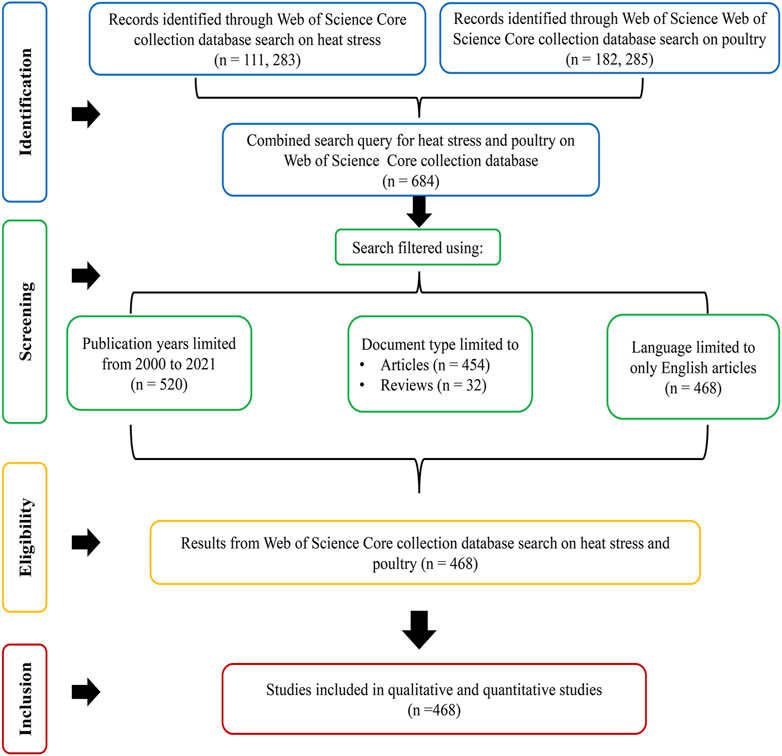
FIGURE 1. Schematic illustration of the search strategy conducted to retrieve published articles on heat stress in poultry from 2000 to 2021.
2.3 Data extraction
The retrieved documents were extracted using the “Export Records to File” button and the “Full Records and Cited References” option on WoSCC. The plain text, RIS, BibTeX, excel, and tab-delimited files were downloaded for further processing. The exported data included information on authors, publication years, document types, web of science categories, affiliations, journals, funding agencies, countries, research areas, citations, and keywords. The journal impact factor (IF) and category quartile were obtained from the 2021 Journal Citation Reports. The quality of publications was evaluated using the number of citations and the Hirsh-index (h-index).
2.4 Bibliometric analysis
Qualitative and quantitative analysis was performed using the Biblioshiny app on R studio (version 2022.07.1 + 554) (Aria and Cuccurullo, 2017). This platform was used to generate results for main publication information, annual production and citations, author’s impact, relevant affiliations, relevant sources, most cited countries, WordCloud analysis, thematic evolution, and factorial analysis. The bibliometric online analysis platform (https://bibliometric.com), was used to analyze and visualize the partnership analysis between countries.
The VOSviewer software (version 1.6.11) developed by Nees Jan van Eck and Ludo Waltman (van Eck and Waltman, 2010), was used for creating, visualizing, and exploring bibliometric maps based on network data. VOSviewer was used to analyze the co-authorship of authors, countries, and institutions; co-occurrence of all keywords; citation analysis of documents, sources, authors, institutions, and countries; bibliographic coupling of documents, sources, authors, and countries; and the co-citation analysis of cited references, cited sources and cited authors. The network data were generated as network visualization and overlay visualization and interpreted accordingly. The nodes on the maps were representative of the analyzed element (that is, author, country, institution, source, or document). The line between nodes represents the link between two elements, and the thickness of the lines represents the link strength of their connections. The size of an element was determined based on its total link strength (TLS), and different colors were used to differentiate elements into different clusters (van Eck and Waltman, 2010; Cheng et al., 2022).
2.5 Data analysis
R software (version 4.2.1), GraphPad Prism (version 8.0.2), and Microsoft Excel 2016 were used to perform descriptive statistics and plot charts. The Spearman correlation coefficients were conducted using GraphPad Prism. Data were considered statistically significant at p < 0.05.
3 Results
3.1 Annual growth of publication and citations
A total of 468 documents on heat stress and poultry research. These included 93.16% of articles and 6.84% of reviews from 144 sources. The average citation per document was 24.11, and the documents had an average age of 6.12 years. The studies involved a total of 1, 679 authors, with 13 single-authored documents and 5.2 co-authors per document. The results revealed an international collaboration rate of 24.36% among the authors as shown in Table 1.
The annual publications and average citations from 2000 to 2021 are shown in Figure 2A. The annual production of publications on heat stress in poultry rose steadily from three documents as at 2000 to 79 documents in 2021, with an annual growth rate of 4.56%. Correspondingly, the average citations increased from 2.29 in 2000 to the highest point of 7.60 in 2014, and it was at 4.79 in 2021. A significant correlation coefficient was established between the number of publications and the average number of citations for the past 22 years (r = 0.5438, p > 0.0089). Figure 2B shows the United States dominated the number of publications until 2005. However, China made significant developments from 2006 and has increasingly dominated the number of publications in this field.
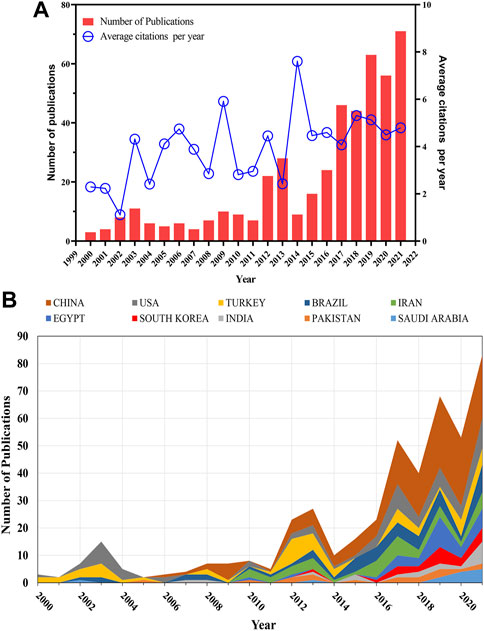
FIGURE 2. Trends in annual publications on heat stress in poultry. (A) Annual number of publications and average citation of articles. (B) Annual publication trends from top productive countries.
3.2 Contribution of funding agencies and institutions
A summary of the top 10 most active funding agencies is shown in Figure 3A. Five of these were from China and the top three funding agencies that supported research on heat stress in poultry were the National Natural Science Foundation of China (n = 57, 12.18%), Conselho Nacional De Desenvolvimento Cientifico E Tecnologico (n = 19, 4.06%), and National Key Research and Development Program of China (n = 13, 2.78%). Figure 3B shows that among the WoSCC subject categories, the top three areas with the highest contribution to heat stress in poultry were Agriculture, Dairy, Animal Science (n = 267), Veterinary Science (n = 93), and Zoology (n = 41).
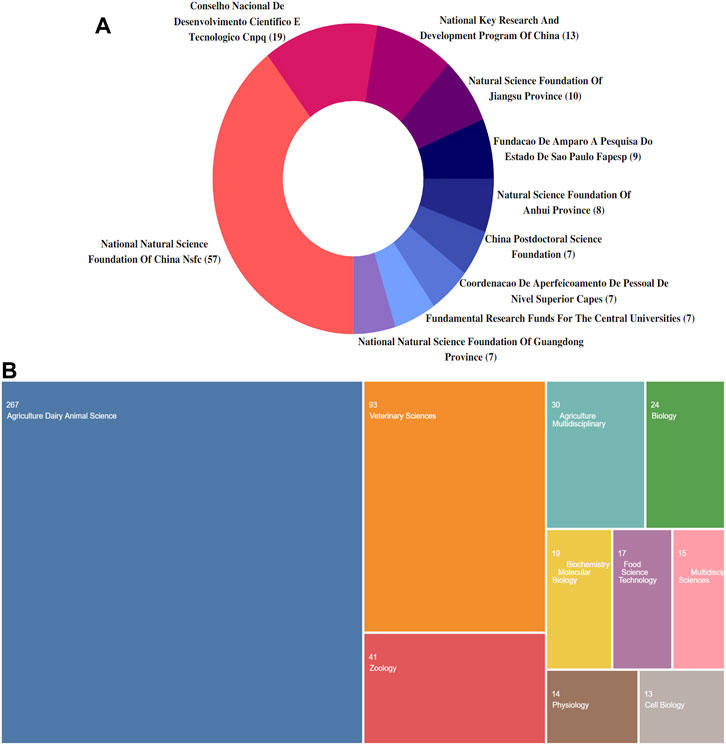
FIGURE 3. Overview of global research on heat stress in poultry. (A) Contribution of various funding bodies. (B) Research areas according to subject categories.
As shown in Figure 4A, the most relevant institutions that published on heat stress in poultry were majorly from China (25%) and the United States (15%). The top institutions with the highest number of publications were Nanjing Agricultural University (China, n = 96), Firat University (Turkey; n = 69), and Universiti Putra Malaysia (Malaysia, n = 40). Co-authorship analysis of the author’s institutions (minimum of three documents) showed that 58 institutions formed the largest set of connections (Figure 4B). A total of 11 institutional clusters were formed with five links and 151 TLS. In the network visualization map, Nanjing Agricultural University had the largest node with the greatest total link strength (TLS = 26). Other top collaborating institutions were Iowa State University (TLS = 19), University Estadual Maringa (TLS = 14), Firat University (TLS = 13), and Zagazig University (TLS = 12).
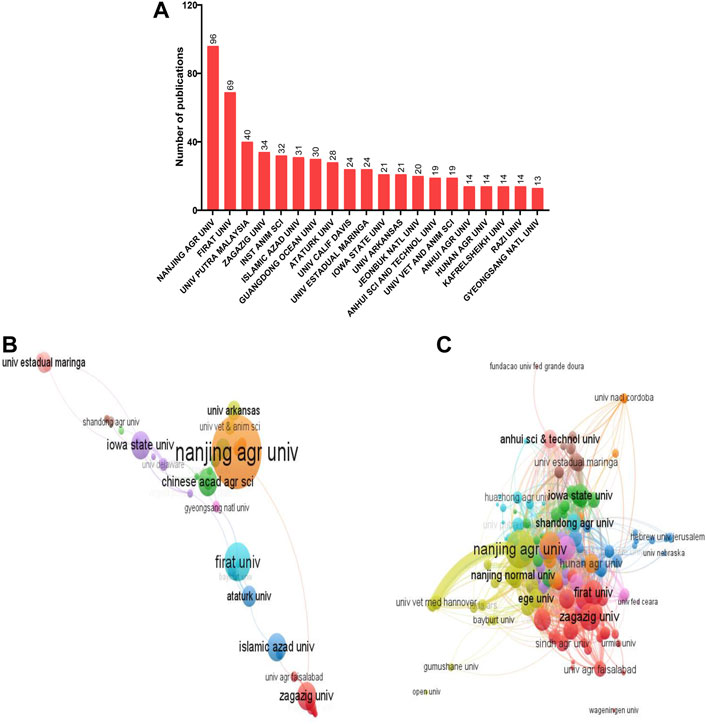
FIGURE 4. Analysis on the institutional contributions to research on heat stress in poultry. (A) Most relevant affiliations. (B) Network visualization for co-authorship analysis of contributing institutions. (C) Network visualization for the citation analysis of contributing institutions. The larger the node, the greater the institutional contribution, and the thicker the line, the greater the link strength between the connected institutions.
For the citation analysis, a total of 139 institutions (minimum number of documents of two) met the threshold and formed the largest connection (Figure 4C). The density between the institutions showed that they were closely related in terms of their citation links. Key institutions were Nanjing Agricultural University (TLS = 503), Zagazig University (TLS = 242), Firat University (TLS = 200), Iowa State University (TLS = 150), and Nanjing Normal University (TLS = 130). Importantly, it was observed that Nanjing Agricultural University had the greatest citation linkages with the Chinese Academy of Agricultural Sciences, Anhui University of Science and Technology, and University of Veterinary Medicine Hanover.
3.3 Contribution of countries
From Table 2, analysis for the most relevant country based on the corresponding authors revealed that China had the highest number of publications, followed by Turkey, Brazil, United States, and Iran. These accrued from both single- and multi-country publications. Interestingly, the multiple-country publication (MCP) analysis showed that France (MCP_Ratio:0.750) and the Netherlands (MCP_Ratio: 0.750) had the highest collaboration ratio (data not shown). Among the top 20 most cited countries, China had the highest total citations, followed by Turkey, United States, Iran, and Japan. Correspondingly, the collaboration network among contributing countries showed that China had close collaboration with Unites States, Germany, Australia, Egypt, Japan, and Turkey (Figure 5A).
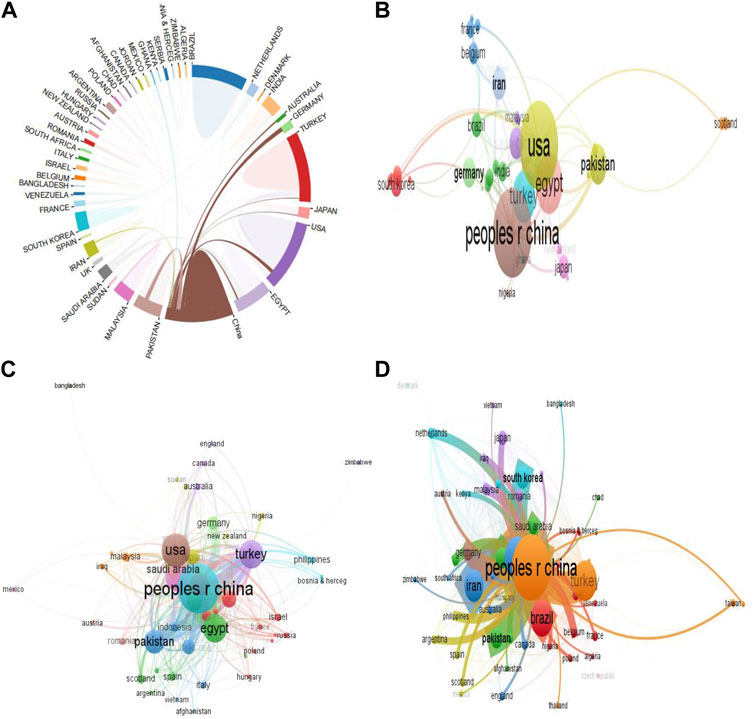
FIGURE 5. Countries contributions to research on heat stress in poultry. (A) Interrelationship between contributing countries. (B) Co-authorship mapping of countries. (C) Citation analysis of countries. (D) Bibliographic coupling of countries. The larger the node, the greater the country’s contribution, and the thicker the line, the greater the link strength between two connected countries.
Co-authorship analysis of contributing countries showed that 46 countries constituted the largest connection (Figure 5B). They were grouped into 12 clusters, having 10 links and 178 TLS. Prominent countries with the largest connections were the People’s Republic of China (TLS = 45), United States (TLS = 44), Egypt (TLS = 29), Pakistan (TLS = 18), and Saudi Arabia (TLS = 14). The network analysis revealed that China had great co-authorship linkages with the United States, Pakistan, Germany, and Egypt. Correspondingly, the citation analysis showed that 49 countries were connected, with a total TLS of 265, 42 links, and were grouped into 11 clusters. The five most prominent countries were the People’s Republic of China (TLS = 1,055), United States (TLS = 538), Turkey (TLS = 413), Egypt (TLS = 416), and Pakistan (TLS = 314) (Figure 5C). Evidently, China had greater citation linkages with United States, Pakistan, Iran, Egypt, and Turkey.
In addition, the bibliographic coupling analysis of contributing countries (Figure 5D) showed that all 54 countries were connected and were categorized into 8 clusters having 109 links and 108, 141 TLS. Among the countries, People’s Republic of China (TLS = 40 822), United States (TLS = 20,421), Egypt (TLS = 20,213), Iran (TLS = 14,097), and Turkey (TLS = 13,270) had the highest TLS. Importantly, the People’s Republic of China was able to establish strong connections with countries such as United States, Brazil, Pakistan, Turkey, Iran, and South Korea.
3.4 Document sources
A total of 144 sources of documents were identified in this study. The top 20 journals with publications on heat stress in poultry are shown in Table 3. Based on the number of articles produced the most prolific journal was Poultry Science. This was followed by British Poultry Science, Journal of Thermal Biology, Animals, and Brazilian Journal of Poultry Science. Correspondingly, the total citations increased with these journals (Poultry Science and British Poultry Science), except that Worlds Poultry Science Journal had higher citations than Journal of Thermal Biology, which was followed by Biological Trace Element Research. Among these top 20 journals, the Journal of the Science of Food and Agriculture had the highest impact factor, and 60% of these journals were partitioned into JCR Q1.
A total of 111 sources formed the largest set of connections for citation analysis (Figure 6A). These sources had 681 links and 1,572 TLS. They were grouped into 17 clusters and the document sources with the strongest TLS were Poultry Science (TLS = 574), Journal of Thermal Biology (TLS = 243), World’s Poultry Science Journal (TLS = 207), Animals (TLS = 150) and British Poultry Science (TLS = 146). Interestingly, Poultry Science journal formed the greatest citation network with co-journals including Journal of Thermal Biology, British Poultry Science, World’s Poultry Science Journal, and Animals. The bibliographic coupling of sources showed that 128 sources formed the largest bibliographic connection with 4,262 links, TLS of 55,653 and they were grouped into 9 clusters (Figure 6B). Poultry Science had the largest network (TLS = 13,909), followed by Journal of Thermal Biology (TLS = 9,995), World’s Poultry Science Journal (TLS = 7,046), Animals (TLS = 6,092), and British Poultry Science (TLS = 3,719). Similar to the citation analysis, it was revealed that Poultry Science established strong bibliographic coupling with co-journals including Journal of Thermal Biology, World’s Poultry Science Journal, Animals, and British Poultry Science.
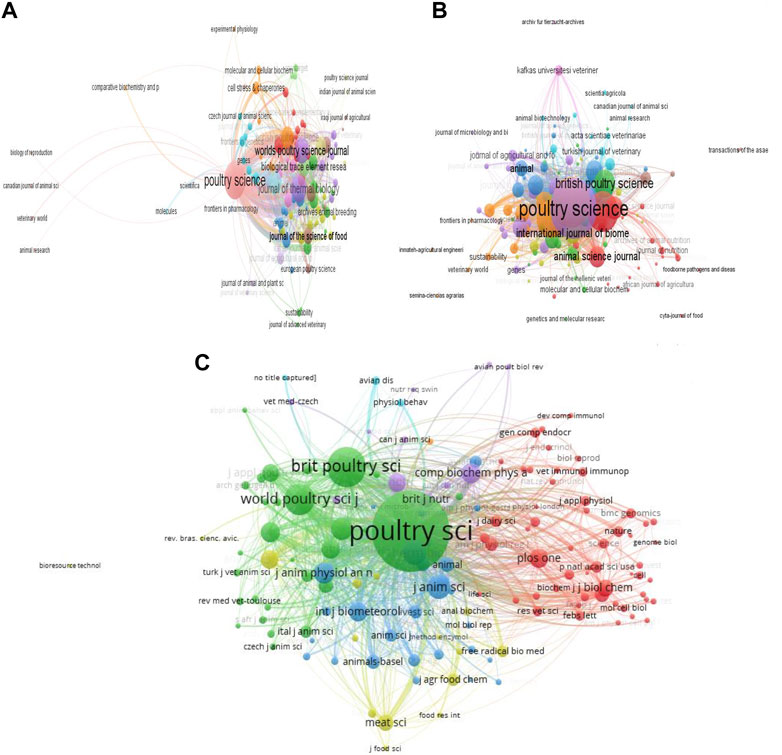
FIGURE 6. Journals contributing to research on heat stress in poultry. (A) Citation analysis of sources. (B) Bibliographic coupling of sources. (C) Co-citation analysis of cited sources. The larger the node, the greater the journal’s contribution, and the thicker the line, the greater the link strength between two journals.
In total, 142 sources of documents (minimum number of citations per source = 20) were analyzed for the co-citation network of their cited sources (Figure 6C). Similar to the citation and bibliographic coupling networks, Poultry Science journal had the largest network of co-cited sources (TLS: 115,035). Other top co-cited sources were British Poultry Science (TLS = 31,960), World’s Poultry Science Journal (TLS = 20,901), Journal of Thermal Biology (TLS = 13,199), and Journal of Animal Science (TLS = 12,769). Importantly, Poultry Science had a great co-citation network with other journals especially, British Poultry Science, World’s Poultry Science Journal, International Journal of Poultry Science, and Journal of Animal Science and Biotechnology.
3.5 Authorship analysis
A total of 1,679 authors contributed to the 468 documents on heat stress in poultry from 2000 to 2021. Table 4 shows that the top five authors with the highest global contributions were Kazim Sahin (Firat University, Turkey), followed by Nurhan Sahin (Firat University, Turkey), Feng Gao (Nanjing Agricultural University, China), Li Zhang (Guangdong Ocean University, China) and Endong Bao (Nanjing Agricultural University, China). Interestingly, researchers from Nanjing Agricultural University, China constituted about 45% of the top 20 contributing authors, while China alone had 75% of the top 20 authors, followed by Turkey at 20%.
The co-authorship analysis showed that several of the authors were not connected, whereas the largest network had 69 authors, 304 links, and 309 TLS. Figure 7A shows that the five authors with significant co-authorship connections were Alagawany, Mahmoud (TLS = 26), Naiel Mohammed A.E (TLS = 21), Abd El-Hack, Mohamed E. (TLS = 21), Abdel-Moneim, Abdel-Moneim Eid (TLS = 17), and Shehata, Abdelrazeq M (TLS = 15). The co-authorship network revealed that of the few connected researchers, there was a close association between the different clusters. This suggests that the active authors on heat stress in poultry had established a centralized and concentrated network, but still lacked extensive collaboration with other scholars. Citation analysis of authors with a minimum of two documents showed that 308 authors formed the largest connection, with a total TLS of 10,244; 5,504 links, and they were categorized into 10 clusters (Figure 7B). Five authors with the strongest TLS were Gao, Feng (TLS = 366), Bao, Endong (TLS = 331), Tang, Shu (TLS = 282), Lamont, Susan J (TLS = 193), and Alagawany Mahmoud (TLS = 160). The co-citation network of cited authors revealed that a total of 115 authors were connected (minimum number of citations per author: 20) with 5,440 links; 42; 054 TLS, and they formed 5 clusters (Figure 7C). Top co-cited authors in the network were Sahin, K (TLS = 5,081), Yahav, S. (TLS = 2,849), Attia, Y.A (TLS = 2,551), Quinteiro, W.M (TLS = 2,183), and Lin, H (TLS = 5,081). Results from both the citation and bibliographic coupling analysis showed that Bao, Endong, and Tang, Shu who are major contributors affiliated with Nanjing Agricultural University, China were isolated in a distinct cluster.

FIGURE 7. Analysis of the authorship network for global research on heat stress in poultry. (A) Co-authorship mapping of authors. (B) Citation analysis of authors. (C) Co-citation analysis of authors. (D) Bibliographic coupling analysis of authors. The larger the node, the greater the author’s contribution, and the thicker the line, the greater the link strength between two authors.
Network visualization map showing the bibliographic coupling of authors also revealed that a total of 125 authors were connected (minimum number of documents: 3), with 6,721 links, total TLS of 152,247, and that they were grouped into 6 clusters (Figure 7D). Gao, Feng (TLS = 7,084), Lamont, Susan (TLS = 6,529), Bao, Endong (TLS = 5,435), Gasparino, Eliane (TLS = 5,097), and Sahin K (TLS = 5,054) were among the authors with the greatest TLS.
3.6 Documents and co-cited documents
The top 10 most globally cited documents on heat stress in poultry are presented in Table 5. “Effect of heat stress on oxidative stress, lipid peroxidation and some stress parameters in broiler” by Altan O. et al. (2003) was the most cited document. Two review articles were included in the top 10 globally cited documents. “Strategies for preventing heat stress in poultry” by Lin H et al. (2006) and “Association between heat stress and oxidative stress in poultry; mitochondrial dysfunction and dietary interventions with phytochemicals” by Akbarian A. et al. (2016).
Following citation analysis (Figure 8A), the network visualization map showed that a total of 304 documents (minimum number of citations per document = 5) formed the largest set of connected items, which were grouped into 19 clusters. From the citation analysis, the following documents: Altan et al. (2003) (citations = 294, links = 39), Lin et al. (2006) (citations = 250, links = 35), Bartlett (2003) (citations = 246, links = 35), Akbarian et al. (2016) (citations = 219, links = 43), and Sohail et al. (2010) (citations = 215, links = 37) had the highest citation and linkages. Bibliographic coupling of documents revealed that 156 documents were connected (minimum number of citations per documents: 20) with a total TLS of 10,770, 406 links and they were distributed into 7 clusters (Figure 8B). The following; Wang et al. (2021) (TLS = 554), Abdel-Moneim et al. (2021) (TLS = 504), Farag and Alagawany (2018) (TLS = 430), Lin et al. (2006) (TLS = 338), and Kumar et al. (2021) (TLS = 325) were among the top documents with high TLS.
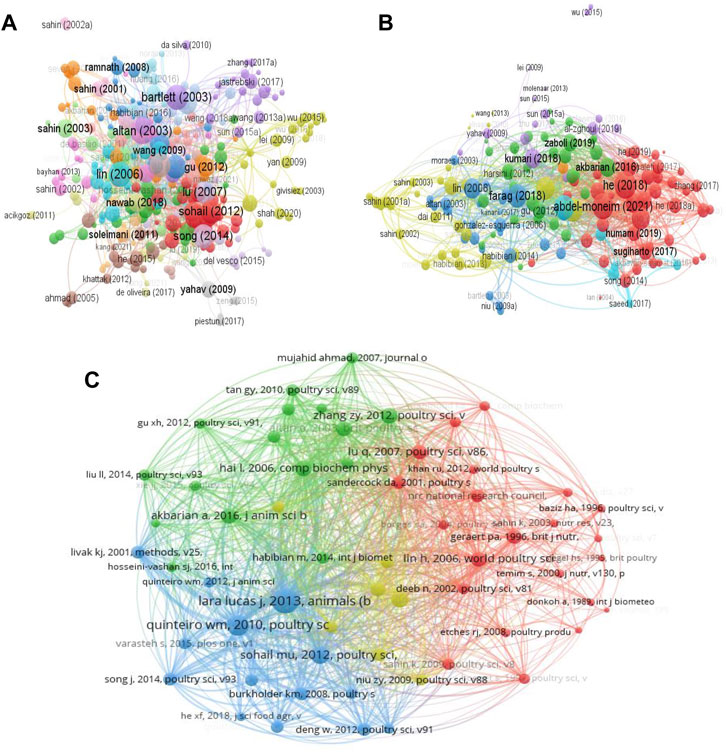
FIGURE 8. Network visualization of documents on heat stress in poultry. (A) Citation analysis of documents. (B) Bibliographic coupling analysis of documents. (C) Co-citation network of documents.
Analysis of the co-citation network of cited references (minimum number of citations per cited reference = 20) showed that 59 cited references formed a network of 1,548 links, 6,334 TLS and were grouped into 4 clusters (Figure 8C). Top five cited references included Lara and Rostagno (2013) (TLS = 1,377) which was published in Animals (Basel), followed by Quinteiro-Filho et al. (2010) (TLS = 994), Mashaly MM (2004) (TLS = 737), Sohail MU (2012) (TLS = 700), and Zhang ZY (2012) (TLS = 629). The last four cited references were all published in Poultry Science. Moreover, the strongest co-citation connection was found between the cited references, Lara and Rostagno (2013); and Quinteiro-Filho et al. (2010) (link strength = 37)
3.7 Keyword analysis
WordCloud analysis showed that “chickens” (127), “growth performance” (125), “supplementation” (75) “performance” (74), and “oxidative stress” (60) were the top five Keyword Plus with the highest frequency (Figure 9A). Co-occurrence analysis (minimum occurrence of each keyword = 5) categorized all the keywords into six clusters (Figure 9B). The top six keywords in terms of co-occurrence were “heat stress” (TLS = 1,884), “growth performance” (TLS = 1,027), “chickens” (TLS = 988), “broiler” (TLS = 961), “performance” (TLS = 781), and “oxidative stress” (TLS = 684) (Figures 9B, C). The overlay visualization showed that the keyword “heat stress” co-occurred with several current topics including “meat quality”, “antioxidants”, “microflora”, “intestinal barrier”, “expression”, and “rna-seq” (Figure 9C).
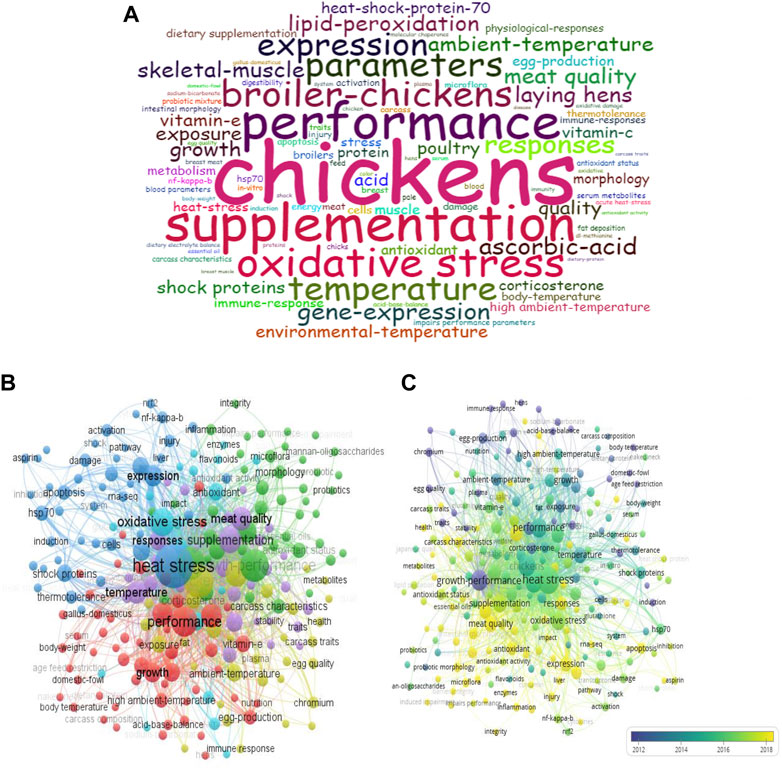
FIGURE 9. Analysis for Keywords associated with global research on heat stress in poultry. (A) Word cloud analysis of Keyword Plus. (B) Network visualization for all keywords co-occurrence. (C) Overlay visualization for the co-occurrence analysis of all keywords.
To understand the research trend on heat stress in poultry over time, a thematic evolution analysis was conducted by grouping the Keyword Plus into four periods (2000–2005, 2006–2010, 2011–2015, and 2016–2021). Supplementary Table S1 gives detailed information on Keyword plus classification and the properties of the clusters/time series. As shown in Figure 10A, from 2000 to 2005 had key terms such as environmental temperature, oxidative stress, and chickens; 2006 to 2010 had terms such as lipid-peroxidation, oxidative stress; environmental temperature; 2011 to 2015 had high frequency for performance, supplementation, and chickens, and the period between 2016 and 2021 included terms such as oxidative stress, growth performance, and temperature.
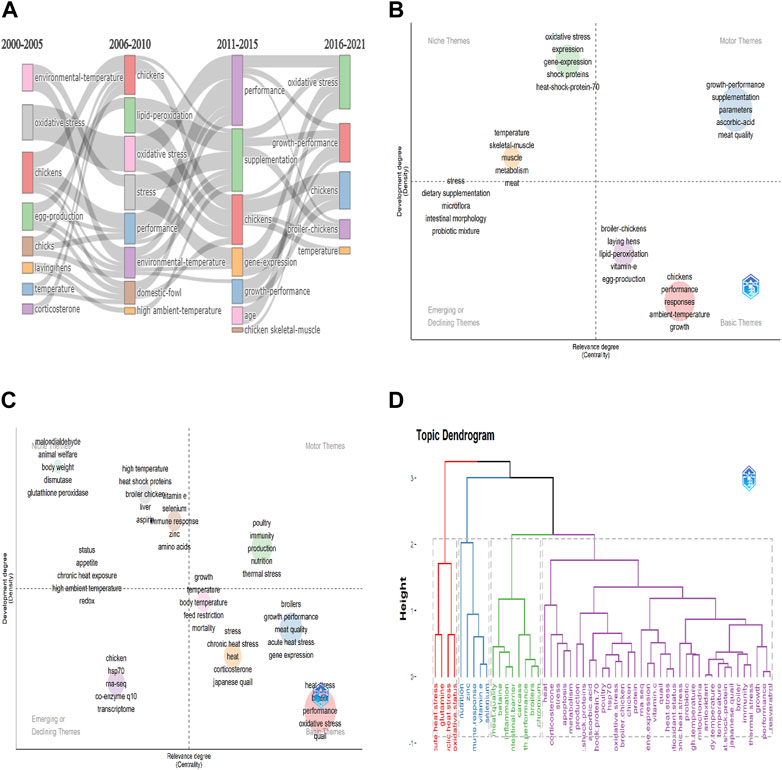
FIGURE 10. Keywords analysis for global research terms on heat stress in poultry. (A) Thematic evolution of Keyword Plus from 2000 to 2021. (B) Thematic map analysis of Keyword Plus (C) Thematic map analysis of authors keywords. (D) Topic dendrogram using multiple correspondence analysis of authors keywords to show the hierarchical relationship between terms.
Thematic map analysis was carried out for the Keyword plus and Author keywords (Figures 10B, C). For the Keywords plus, the motor theme covered terms such as growth performance, ascorbic acid, and meat quality. The niche themes were terms related to oxidative stress, gene expression, and muscle metabolism. The emerging or declining themes covered terms such as stress, dietary supplementation, microflora, intestinal morphology, and probiotic mixture, while the basic themes included terms related to broiler chickens, lipid peroxidation, and ambient temperature (Figure 10B). Thematic mapping of the Authors keywords showed that the motor theme included immunity, nutrition, and thermal stress. The niche theme had terms associated with oxidative stress, heat shock proteins, and chronic heat exposure. The emerging or declining themes featured terms such as chicken, hsp 70, rna-seq, co-enzyme 10, and transcriptome, while the basic theme had growth performance, terms related to heat stress, and gene expression (Figure 10C). Figure 10D shows the conceptual framework of Author keywords (n = 50) using the multiple correspondence analysis. The results showed that the keywords were categorized into four clusters of 4, 5, 8, and 33 elements, respectively. Key terms including “acute heat stress, “cyclic heat stress” and “oxidative status” were covered in the first cluster, whereas, the last cluster which had the largest number of elements (n = 33) covered terms closely related to heat stress, growth performance, gene expression, production, and metabolism.
4 Discussion
Over the last decades, with the increasing awareness and global actions towards climate change and global warming, research on heat stress in farm animals especially poultry has gained attention, as evidenced by the annual increment in the number of publications. The number of publications and citation counts achieved each year is an indicator of the research interest and progress made by researchers in that specific area (Musa et al., 2020; Xu et al., 2022). Several researchers, countries, institutions, and industry partners have collaborated on studies to address “heat stress in poultry”, thus necessitating this bibliometric analysis to understand the milestones achieved, research gaps uncovered, and the trends for future research. Over the past two decades, the annual publications on heat stress in poultry showed a significant increase, and so far, the highest number of articles was achieved in 2021. The annual number of publications increased relatively slowly from 2000 until 2011, with fewer than 15 articles per year. The increase observed from 2012 could possibly occur due to increasing awareness of the impacts of heat stress on poultry (Lin et al., 2006; Yahav, 2009) and its association with oxidative stress (Altan et al., 2003; Mujahid et al., 2005), as seen from the records of top globally cited documents. More so, the dietary manipulation of heat stress in poultry using prebiotics and probiotics (Lan et al., 2004; Sohail et al., 2010), polyphenols (Pena et al., 2008; Aengwanich and Suttajit, 2010), amino acids (Zarate et al., 2003; Dai et al., 2011), as well as, minerals and vitamins (Sahin et al., 2002; Niu et al., 2009; Mohiti-Asli et al., 2010; Vakili et al., 2010; Moeini et al., 2011) etc., were gradually gaining research attention. The last 5 years have witnessed production exceeding 40 documents annually, accounting for 61.9% of the total documents. The increase in the number of publications was positively associated with the rise in the average annual citation in a monotonic relationship. Also, it is expected that with an increase in the number of citable years, the average citation will continue to increase. Therefore, consistent efforts to foster research and collaboration are necessary to drive annual publications, growth rate, and article citations on heat stress and poultry.
Importantly, China ranked foremost in its contribution to research on heat stress in poultry in terms of publications, top contributing authors, funding agencies, institutional affiliations, and corresponding authorship. The network analysis also revealed that China significantly cooperated with other countries including United States, Egypt, Turkey, Germany, and Australia. In terms of co-authorship, citations, and bibliographic coupling, China had the greatest connections, networks, and TLS with other countries. This may be closely attributed to the significant financial investments by the Chinese government to support research on heat stress in poultry. The study revealed that out of the top 10 funding agencies, five were sponsors from China including the National Natural Science Foundation of China, National Key Research and Development Program of China, and Natural Science Foundation of Jiangsu Province. Evidently, the most productive institutions were also from China, with the most significant being the Nanjing Agricultural University. The institutional networks for co-authorship and citation analysis further revealed that Nanjing Agricultural University played a significant role in establishing strong research cooperation and collaboration with other institutions both within and outside China.
With respect to the authors, Kazim Sahin from Firat University, Turkey, Nurhan Sahin from Firat University, Turkey, and Feng Gao from Nanjing Agricultural University, China contributed the highest to global research on heat stress in poultry. Studies by Kazim Sahin and Nurhan Sahin were majorly centered on vitamin and mineral metabolism, quail production, phytochemicals, oxidative stress, and heat stress alleviation (Sahin et al., 2012; Sahin et al., 2013; Sahin et al., 2017; Orhan et al., 2021). Both authors were closely affiliated and collaborated on most of their research. On the other hand, Feng Gao focused on studies related to muscle metabolism, taurine supplementation, heat stress-induced oxidative damage, and the effects of chronic heat stress on broilers (Lu et al., 2017; Ma et al., 2018; Lu et al., 2019; Ma et al., 2021). Furthermore, the co-authorship analysis revealed that several of the authors, even those with a higher number of publications were excluded from the network. In line with this, the international co-authorship of authors was found to be 24.36%, thus suggesting that the inter-collaborative efforts of authors in this research field were relatively low. In addition, research works from Gao, Feng; Bao, Endong; Tang, Shu; Lamont, Susan J; and Alagawany Mahmoud were highly cited by other authors, while the works from Sahin, K., Yahav, S., Attia, Y.A., Quinteiro, W.M., and Lin, H. were among the top co-cited papers, suggesting that they contributed to the high impact papers sought after in the field. Consequently, documents from these authors were also found among the top globally cited research in this field (Sahin and Kucuk, 2003; Lin et al., 2006; Yahav, 2009; Attia et al., 2021). The bibliographic coupling of authors characterizes the phenomenon where two authors cite similar document (s) in the articles that they have published (Ma, 2012; Zhang and Yuan, 2022). Findings from both the citation and bibliographic coupling analysis showed that Bao, Endong and Tang, Shu who were affiliated with Nanjing Agricultural University, China had a strong connection in their bibliographic network, suggesting that these authors have close similarities in their research outputs. Altogether, key scholars who have contributed quantitatively or qualitatively to promoting research on heat stress in poultry were identified, indicating their substantial contributions to the field.
Bibliometric analysis of document sources (including journals, books, etc.) is important in providing updated insights and trends for a particular research area, as well as in guiding scholars to select suitable journals for their research communication (Cheng et al., 2022; Liu et al., 2022). Journals including Poultry Science, British Poultry Science, Journal of Thermal Biology, Animal, and Brazilian Journal of Poultry Science were the most prolific sources of articles on heat stress in poultry and they also accrued higher citation index. Journal co-citation analysis and bibliographic coupling further emphasized that Poultry Science had the largest network and was strongly connected with other journals such as Journal of Thermal Biology, World’s Poultry Science Journal, Animals, and British Poultry Science. These may be related to the publication of high-impact findings in these journals, thus suggesting that the hot topics and future trends emanating from research on heat stress in poultry are likely to be reported in these journals. Evidently, Poultry Science journal produced most of the top globally cited articles, revealing that this journal is a relevant, consistent, and authoritative source for high-caliber research and information related to poultry production.
The article, titled “Effect of heat stress on oxidative stress, lipid peroxidation and some stress parameters in broiler” by Altan O. et al. (2003) was identified as the most globally cited document on heat stress in poultry. Key findings of this study were that heat stress increased fearfulness, induced oxidative stress, and initiated significant physiological responses in broilers (Altan et al., 2003). Two review articles also contributed significantly to the global research progress on heat stress in poultry. They were “Strategies for preventing heat stress in poultry” by Lin H et al. (2006) and “Association between heat stress and oxidative stress in poultry; mitochondrial dysfunction and dietary interventions with phytochemicals” by Akbarian A. et al. (2016). Given the widespread concerns on how to mitigate the adverse impacts of heat stress in poultry production, Lin et al. (2006) was among the early reports to surmise various methods, which included, genetic, nutritional, feeding, and environmental strategies that can be adopted to cope with heat stress in poultry. In addition, following the discovery that oxidative stress was closely associated with heat stress in poultry, Akbarian et al. (2016) provided a detailed discussion that explained the mechanisms through which heat stress induces oxidative stress, and also presented the use of antioxidant phytochemicals as a nutritional strategy for the alleviation of mitochondrial dysfunction in heat-stressed birds. From the citation networks, documents including Altan et al. (2003), Bartlett (2003), Lin et al. (2006), Akbarian et al. (2016), and Sohail et al. (2010) had the greatest linkages and also contributed substantially to the advancement of research on heat stress in poultry. Several documents were commonly cited by scholars in this research area, especially the works of Lara and Rostagno (2013) which reported on the “Impact of heat stress on poultry production” and Quinteiro-Filho et al. (2010) which reported that “Heat stress impairs performance parameters, induces intestinal injury, and decreases macrophage activity in broiler chickens”.
Keywords are considered important terms and phrases from a research paper that rightly expresses the content covered, help generate new information and frontiers of knowledge, and assist in the retrieval of relevant content. Commonly, author-generated keywords (that is, Author keywords) are provided during article submission to describe the main contents/concepts addressed in their research. Also, the Keyword Plus is generated by Web of Science from the words and phrases that occur in the titles of cited references (Tripathi et al., 2018). Therefore the use of both author keywords and Keyword Plus explicitly expresses the knowledge structure, the article’s content, and the interactions of various research in a given subject area (Zhang et al., 2016). In this study, the top five keywords with the highest WordCloud frequency were “chickens”, “growth performance”, “supplementation”, “performance”, and “oxidative stress”. Word Cloud provides a visual representation of texts that are frequently occurring, such that the bigger and bolder a word appears, the higher its frequency of occurrence. Interestingly, the keyword “oxidative stress” had a higher occurrence than “heat stress” revealing a shift in research interest, which suggest that more researchers were gradually getting involved with studies that addressed oxidative stress in poultry. In addition, the thematic evolution of Keyword plus identified that research on oxidative stress had gained momentum over the years. Importantly, the thematic growth on oxidative stress had evolved to integrate other terms related to performance, supplementation, gene expression, and growth performance. This was also consistent with the overlay visualization which showed that heat stress co-occurred with various new topics such as “meat quality”, “antioxidants”, “microflora”, “intestinal barrier”, “expression”, and “rna-seq”.
The co-occurrence network of all keywords unveiled that current research on heat stress in poultry mainly focused on studies of growth performance, environment and production (red nodes), studies on intestinal morphology, and microbiota (green nodes), studies on the molecular mechanisms of heat stress (blue nodes), studies on immune response and metabolites, studies on meat quality and carcass characteristics (purple nodes), and studies on oxidative stress (aqua nodes). With the recent development in research, it is interesting to note that several terms have emerged in relation to heat stress such as “essential oils”, “resveratrol”, “betaine”, “curcumin”, “probiotic mix”, “flavonoids”, and “plant extracts”. These are important agents provided as supplements to poultry in a bid to alleviate the detrimental effects of heat stress. Several studies have demonstrated their protective and beneficial effects on the growth performance, behavior and welfare, immune system, antioxidant capacity, egg production, nutritional metabolism, intestinal health, thermotolerance, and other physiological variables of heat-stressed birds (Nawab et al., 2020; Sariozkan et al., 2020; Jiang et al., 2021; Liu et al., 2021; Mohammadi, 2021; Wen et al., 2021; Yang et al., 2021).
The thematic map analysis of keywords allows for the organization of keyword groupings according to their density and centrality into a single circle for mapping as a two-dimensional image (Ejaz et al., 2022). From the Keyword plus, it was identified that motor topics including “growth performance”, “supplementation”, “ascorbic acid research”, and “meat quality”, have been well-researched with respect to heat stress in poultry (Mahmoud et al., 2004; Abidin and Khatoon, 2013; Kumar et al., 2021; Piray and Foroutanifar, 2021). However, some topics that were weakly developed from both the emerging and declining themes (microflora, intestinal morphology, and probiotic mixture) and the basic themes (lipid-peroxidation, egg production, and ambient temperature) could be of research interest for further studies on heat stress in poultry. In examining the Author keywords, some underdeveloped and marginally important topics grouped into the emerging and declining themes were “hsp70”, “rna-seq”, “co-enzyme q10”, and “transcriptome”. To address this, studies have reported that co-enzyme q10 protects the chicken primary myocardial cells against damage and apoptosis during in vivo heat stress by upregulating hsp70 expression and HSF1 binding activity (Xu et al., 2017a; Xu et al., 2017b; Xu et al., 2019b), and that co-enzyme q10 induced autophagy and suppressed the PI3K/AKT/mTOR signaling as a protective mechanism against heat stress (Xu et al., 2019a). Alongside this, several studies have employed the whole transcriptomics approach, as well as other RNA sequencing technology to investigate the effects of heat stress in poultry (Saelao et al., 2018; Te Pas et al., 2019; Kim et al., 2021; Liang et al., 2021). With the advent of this tool, the molecular mechanisms that occur in distinct cells or tissues of various poultry species during heat stress exposure can be profiled, quantified, and comprehensively understood, thus presenting useful information to advance research in this field. The transcriptomics approach has been utilized to investigate the effects of heat stress on various tissues including the liver (Jastrebski et al., 2017; Wang et al., 2020), bursa (Monson et al., 2018; Chanthavixay et al., 2020), thymus (Monson et al., 2019), cardiac and skeletal muscle (Srikanth et al., 2019), hypothalamus (Sun et al., 2015), and heart (Zhang et al., 2017; Zhang et al., 2019). In addition, some topics which are relevant but weakly developed were identified in the basic theme, such as “corticosterone”, “acute heat stress”’ “chronic heat stress”, “oxidative stress”, “feed restriction, “meat quality”, and “gene expression”. Importantly, these topics may be considered highly relevant and of great potential in stimulating future research and scientific development on heat stress in poultry.
To the best of our knowledge, the present study is the first to examine the global research status and emerging trends on heat stress in poultry species using the bibliometric approach. Noteworthy, research progress in this field is gradually developing with greater growth potential. Presently, the need for extensive global cooperation between authors, institutions, and countries cannot be overemphasized. Current research on heat stress in poultry could be identified as focusing on production performance, physiological responses, oxidative stress, and dietary supplements. However, it is deduced that future research trends will focus more on topics such as; “antioxidants”, “meat quality”, “microflora”, “intestinal barrier”, “rna-seq”, “animal welfare”, “gene expression”, “probiotics”, “feed restriction”, and “inflammatory pathways”. Therefore, this comprehensive analysis of the current status and emerging topics on heat stress in poultry would serve as a useful reference for researchers, policymakers, and other stakeholders in the poultry industry.
5 Limitations of the study
It is important to point out that despite the novelty of this work and the important findings established from this study, there are a few limitations associated with it.
1. The documents retrieved for this study were solely based on the WoSCC database, as such not inclusive of other database collections such as Scopus, Pubmed, Dimension etcetera, which may have more information to deliver. However, it is agreed that Web of Science is the most suitable database and the most recommended for bibliometric studies in a specific field (Cheng et al., 2022; Shan et al., 2022).
2. The documents mined from the search may not necessarily obtain all the related literature due to the diversity of keywords. However, the detailed search strategy employed, the advanced search technique, and the logical use of Boolean operators have helped to improve the relevance and accuracy of retrieved results.
3. The key term in this study “heat stress in poultry” was expressed as “heat stress” AND “Poultry”, with the use of “AND” as a Boolean operator to ensure that all related keywords were retrieved and the search result was narrowed down to only the relevant terms.
Data availability statement
The original contributions presented in the study are included in the article/Supplementary Material, further inquiries can be directed to the corresponding authors.
Author contributions
VU conceptualized the research, and drafted the manuscript. VU and TM conducted the bibliometric analysis, collected the data, and interpreted the results. OEO, JZ, XW, HJ, OO, and HL revised the manuscript and supervised the study. All authors contributed to the final version of the article.
Funding
This work was supported by the Key Technologies Research and Development Program of China (2021YFD1300405), Key Technology Research and Development Program of Shandong province (2019JZZY020602), the Earmarked Fund for China Agriculture Research System (CARS-40-K09), and National Natural Science Foundation of China (31772619).
Conflict of interest
The authors declare that the research was conducted in the absence of any commercial or financial relationships that could be construed as a potential conflict of interest.
Publisher’s note
All claims expressed in this article are solely those of the authors and do not necessarily represent those of their affiliated organizations, or those of the publisher, the editors and the reviewers. Any product that may be evaluated in this article, or claim that may be made by its manufacturer, is not guaranteed or endorsed by the publisher.
Supplementary material
The Supplementary Material for this article can be found online at: https://www.frontiersin.org/articles/10.3389/fphys.2023.1123582/full#supplementary-material
References
Abdel-Moneim A. M. E., Shehata A. M., Khidr R. E., Paswan V. K., Ibrahim N. S., El-Ghoul A. A., et al. (2021). Nutritional manipulation to combat heat stress in poultry – a comprehensive review. J. Therm. Biol. 98, 102915. doi:10.1016/j.jtherbio.2021.102915
Abidin Z., Khatoon A. (2013). Heat stress in poultry and the beneficial effects of ascorbic acid (Vitamin C) supplementation during periods of heat stress. Worlds Poult. Sci. J. 69, 135–151. doi:10.1017/S0043933913000123
Aengwanich W., Suttajit M. (2010). Effect of polyphenols extracted from Tamarind (Tamarindus indica L.) seed coat on physiological changes, heterophil/lymphocyte ratio, oxidative stress and body weight of broilers (Gallus domesticus) under chronic heat stress. Animal Sci. J. 81, 264–270. doi:10.1111/j.1740-0929.2009.00736.x
Akbarian A., Michiels J., Degroote J., Majdeddin M., Golian A., De Smet S. (2016). Association between heat stress and oxidative stress in poultry; mitochondrial dysfunction and dietary interventions with phytochemicals. J. Animal Sci. Biotechnol. 7, 37. doi:10.1186/s40104-016-0097-5
Alagawany M., Elnesr S. S., Farag M. R., Abd El-Hack M. E., Barkat R. A., Gabr A. A., et al. (2021). Potential role of important nutraceuticals in poultry performance and health - a comprehensive review. Res. Veterinary Sci. 137, 9–29. doi:10.1016/j.rvsc.2021.04.009
Altan O., Pabuccuoglu A., Altan A., Konyalioglu S., Bayraktar H. (2003). Effect of heat stress on oxidative stress, lipid peroxidation and some stress parameters in broilers. Br. Poult. Sci. 44, 545–550. doi:10.1080/00071660310001618334
Aria M., Cuccurullo C. (2017). bibliometrix: An R-tool for comprehensive science mapping analysis. J. Inf. 11, 959–975. doi:10.1016/j.joi.2017.08.007
Attia Y. A. E. W., De Oliveira M. C., Abd El-Hamid A. E. H. E., Al-Harthi M. A., Alaqil A., Mohammed N. A. E. M. (2021). Cyclical heat stress and enzyme supplementation affect performance and physiological traits of Japanese quail during the early stage of laying. Animal Sci. Pap. Rep. 39, 89–100.
Azad M. A. K., Kikusato M., Maekawa T., Shirakawa H., Toyomizu M. (2010). Metabolic characteristics and oxidative damage to skeletal muscle in broiler chickens exposed to chronic heat stress. Comp. Biochem. Physiology - A Mol. Integr. Physiology 155, 401–406. doi:10.1016/j.cbpa.2009.12.011
Chanthavixay G., Kern C., Wang Y., Saelao P., Lamont S. J., Gallardo R. A., et al. (2020). Integrated transcriptome and histone modification analysis reveals NDV infection under heat stress affects bursa development and proliferation in susceptible chicken line. Front. Genet. 11, 567812. doi:10.3389/fgene.2020.567812
Chen Y., Long T., Xu Q., Zhang C. (2021). Bibliometric analysis of ferroptosis in stroke from 2013 to 2021. Front. Pharmacol. 12, 817364. doi:10.3389/fphar.2021.817364
Cheng K., Guo Q., Shen Z., Yang W., Wang Y., Sun Z., et al. (2022). Bibliometric analysis of global research on cancer photodynamic therapy: Focus on nano-related research. Front. Pharmacol. 13, 927219. doi:10.3389/fphar.2022.927219
Dai S. F., Gao F., Zhang W. H., Song S. X., Xu X. L., Zhou G. H. (2011). Effects of dietary glutamine and gamma-aminobutyric acid on performance, carcass characteristics and serum parameters in broilers under circular heat stress. Animal Feed Sci. Technol. 168, 51–60. doi:10.1016/j.anifeedsci.2011.03.005
Ejaz H., Zeeshan H. M., Ahmad F., Bukhari S. N. A., Anwar N., Alanazi A., et al. (2022). Bibliometric analysis of publications on the omicron variant from 2020 to 2022 in the Scopus database using R and VOSviewer. Int. J. Environ. Res. Public Health 19, 12407. doi:10.3390/ijerph191912407
Farag M. R., Alagawany M. (2018). Physiological alterations of poultry to the high environmental temperature. J. Therm. Biol. 76, 101–106. doi:10.1016/j.jtherbio.2018.07.012
Han J., Kang H.-J., Kim M., Kwon G. H. (2020). Mapping the intellectual structure of research on surgery with mixed reality: Bibliometric network analysis (2000–2019). J. Biomed. Inf. 109, 103516. doi:10.1016/j.jbi.2020.103516
Jastrebski S. F., Lamont S. J., Schmidt C. J. (2017). Chicken hepatic response to chronic heat stress using integrated transcriptome and metabolome analysis. PLoS ONE 12, e0181900. doi:10.1371/journal.pone.0181900
Jiang S., Yan F. F., Hu J. Y., Mohammed A., Cheng H. W. (2021). Bacillus subtilis-based probiotic improves skeletal health and immunity in broiler chickens exposed to heat stress. Animals 11, 1494. doi:10.3390/ani11061494
Kim H., Kim H., Seong P., Arora D., Shin D., Park W., et al. (2021). Transcriptomic response under heat stress in chickens revealed the regulation of genes and alteration of metabolism to maintain homeostasis. Animals 11, 2241. doi:10.3390/ani11082241
Kumar M., Ratwan P., Dahiya S. P., Nehra A. K. (2021). Climate change and heat stress: Impact on production, reproduction and growth performance of poultry and its mitigation using genetic strategies. J. Therm. Biol. 97, 102867. doi:10.1016/j.jtherbio.2021.102867
Lan P. T. N., Sakamoto M., Benno Y. (2004). Effects of two probiotic Lactobacillus strains on jejunal and cecal microbiota of broiler chicken under acute heat stress condition as revealed by molecular analysis of 16S rRNA genes. Microbiol. Immunol. 48, 917–929. doi:10.1111/j.1348-0421.2004.tb03620.x
Lara L., Rostagno M. (2013). Impact of heat stress on poultry production. Animals 3, 356–369. doi:10.3390/ani3020356
Leishman E. M., Ellis J., van Staaveren N., Barbut S., Vanderhout R. J., Osborne V. R., et al. (2021). Meta-analysis to predict the effects of temperature stress on meat quality of poultry. Poult. Sci. 100, 101471. doi:10.1016/j.psj.2021.101471
Liang Z. L., Jin Y. Y., Guo Y., Qiu S. J., Zhao Y., Zhao Z. H., et al. (2021). Heat stress affects duodenal microbial community of indigenous yellow-feather broilers as determined by 16S rRNA sequencing. Italian J. Animal Sci. 20, 1222–1231. doi:10.1080/1828051X.2021.1970034
Lin H., Jiao H. C., Buyse J., Decuypere E. (2006). Strategies for preventing heat stress in poultry. Worlds Poult. Sci. J. 62, 71–86. doi:10.1079/WPS200585
Liu F. H., Yu C. H., Chang Y. C. (2022). Bibliometric analysis of articles published in journal of dental sciences from 2009 to 2020. J. Dent. Sci. 17, 642–646. doi:10.1016/j.jds.2021.08.002
Liu L., Ren M., Ren K., Jin Y., Yan M. (2020). Heat stress impacts on broiler performance: A systematic review and meta-analysis. Poult. Sci. 99, 6205–6211. doi:10.1016/j.psj.2020.08.019
Liu W. C., Guo Y., An L. L., Zhao Z. H. (2021). Protective effects of dietary betaine on intestinal barrier function and cecal microbial community in indigenous broiler chickens exposed to high temperature environment. Environ. Sci. Pollut. Res. 28, 10860–10871. doi:10.1007/s11356-020-11326-6
Lu Z., He X. F., Ma B. B., Zhang L., Li J. L., Jiang Y., et al. (2017). Chronic heat stress impairs the quality of breast-muscle meat in broilers by affecting redox status and energy-substance metabolism. J. Agric. Food Chem. 65, 11251–11258. doi:10.1021/acs.jafc.7b04428
Lu Z., He X. F., Ma B. B., Zhang L., Li J. L., Jiang Y., et al. (2019). The alleviative effects and related mechanisms of taurine supplementation on growth performance and carcass characteristics in broilers exposed to chronic heat stress. Poult. Sci. 98, 878–886. doi:10.3382/ps/pey433
Ma B. B., He X. F., Lu Z., Zhang L., Li J. L., Jiang Y., et al. (2018). Chronic heat stress affects muscle hypertrophy, muscle protein synthesis and uptake of amino acid in broilers via insulin like growth factor-mammalian target of rapamycin signal pathway. Poult. Sci. 97, 4150–4158. doi:10.3382/ps/pey291
Ma B. B., Zhang L., Li J. L., Xing T., Jiang Y., Gao F. (2021). Heat stress alters muscle protein and amino acid metabolism and accelerates liver gluconeogenesis for energy supply in broilers. Poult. Sci. 100, 215–223. doi:10.1016/j.psj.2020.09.090
Ma R. (2012). Author bibliographic coupling analysis: A test based on a Chinese academic database. J. Inf. 6, 532–542. doi:10.1016/j.joi.2012.04.006
Madkour M., Aboelazab O., Abd El-Azeem N., Younis E., Shourrap M. (2023). Growth performance and hepatic antioxidants responses to early thermal conditioning in broiler chickens. J. Anim. Physiol. Anim. Nutr. Berl. 107, 182–191. doi:10.1111/jpn.13679
Madkour M., Salman F. M., El-Wardany I., Abdel-Fattah S. A., Alagawany M., Hashem N. M., et al. (2022). Mitigating the detrimental effects of heat stress in poultry through thermal conditioning and nutritional manipulation. J. Therm. Biol. 103, 103169. doi:10.1016/j.jtherbio.2021.103169
Mahmoud K. Z., Edens F. W., Eisen E. J., Havenstein G. B. (2004). Ascorbic acid decreases heat shock protein 70 and plasma corticosterone response in broilers (Gallus gallus domesticus) subjected to cyclic heat stress. Comp. Biochem. Physiology B-Biochemistry Mol. Biol. 137, 35–42. doi:10.1016/j.cbpc.2003.09.013
Moeini M. M., Bahrami A., Ghazi S., Targhibi M. R. (2011). The effect of different levels of organic and inorganic chromium supplementation on production performance, carcass traits and some blood parameters of broiler chicken under heat stress condition. Biol. Trace Elem. Res. 144, 715–724. doi:10.1007/s12011-011-9116-8
Mohammadi F. (2021). Effect of different levels of clove (Syzygium aromaticum L.) essential oil on growth performance and oxidative/nitrosative stress biomarkers in broilers under heat stress. Trop. Animal Health Prod. 53, 84. doi:10.1007/s11250-020-02517-x
Mohiti-Asli M., Shariatmadari F., Lotfollahian H. (2010). The influence of dietary vitamin E and selenium on egg production parameters, serum and yolk cholesterol and antibody response of laying hen exposed to high environmental temperature. Arch. fur Geflugelkd. 74, 43–50.
Monson M. S., Van Goor A. G., Ashwell C. M., Persia M. E., Rothschild M. F., Schmidt C. J., et al. (2018). Immunomodulatory effects of heat stress and lipopolysaccharide on the bursal transcriptome in two distinct chicken lines. BMC Genomics 19, 643. doi:10.1186/s12864-018-5033-y
Monson M. S., Van Goor A. G., Persia M. E., Rothschild M. F., Schmidt C. J., Lamont S. J. (2019). Genetic lines respond uniquely within the chicken thymic transcriptome to acute heat stress and low dose lipopolysaccharide. Sci. Rep. 9, 13649. doi:10.1038/s41598-019-50051-0
Mujahid A., Yoshiki Y., Akiba Y., Toyomizu M. (2005). Superoxide radical production in chicken skeletal muscle induced by acute heat stress. Poult. Sci. 84, 307–314. doi:10.1093/ps/84.2.307
Musa T. H., Ahmad T., Li W., Kawuki J., Wana M. N., Musa H. H., et al. (2020). A bibliometric analysis of global scientific research on scrub typhus. Biomed. Res. Int. 2020, 5737893. doi:10.1155/2020/5737893
Nawab A., Tang S., Li G., An L., Wu J., Liu W., et al. (2020). Dietary curcumin supplementation effects on blood immunological profile and liver enzymatic activity of laying hens after exposure to high temperature conditions. J. Therm. Biol. 90, 102573. doi:10.1016/j.jtherbio.2020.102573
Nawaz A. H., Amoah K., Leng Q. Y., Zheng J. H., Zhang W. L., Zhang L. (2021). Poultry response to heat stress: Its physiological, metabolic, and genetic implications on meat production and quality including strategies to improve broiler production in a warming world. Front. veterinary Sci. 8, 699081. doi:10.3389/fvets.2021.699081
Nicolaisen J. (2010). Bibliometrics and citation analysis: From the science citation index to cybermetrics. JASIST 61, 205–207. doi:10.1002/asi.21181
Niu Z. Y., Liu F. Z., Yan Q. L., Li W. C. (2009). Effects of different levels of vitamin E on growth performance and immune responses of broilers under heat stress. Poult. Sci. 88, 2101–2107. doi:10.3382/ps.2009-00220
Oke O. E., Uyanga V. A., Iyasere O. S., Oke F. O., Majokdunmi B. C., Logunleko M. O., et al. (2021). Environmental stress and livestock productivity in hot-humid tropics: Alleviation and future perspectives. J. Therm. Biol. 100, 103077. doi:10.1016/j.jtherbio.2021.103077
Orhan C., Sahin N., Sahin K., Kucuk O. (2021). Influence of dietary genistein and polyunsaturated fatty acids on lipid peroxidation and fatty acid composition of meat in quail exposed to heat stress. Trop. Animal Health Prod. 53, 494. doi:10.1007/s11250-021-02933-7
Pena J. E. M., Vieira S. L., Lopez J., Reis R. N., Barros R., Furtado F. V. F., et al. (2008). Ascorbic acid and citric flavonoids for broilers under heat stress: Effects on performance and meat quality. Braz. J. Poult. Sci. 10, 125–130. doi:10.1590/s1516-635x2008000200008
Piray A., Foroutanifar S. (2021). Chromium supplementation on the growth performance, carcass traits, blood constituents, and immune competence of broiler chickens under heat stress: A systematic review and dose–response meta-analysis. Biol. Trace Elem. Res. 200, 2876–2888. doi:10.1007/s12011-021-02885-x
Quinteiro-Filho W. M., Ribeiro A., Ferraz-de-Paula V., Pinheiro M. L., Sakai M., Sá L. R. M., et al. (2010). Heat stress impairs performance parameters, induces intestinal injury, and decreases macrophage activity in broiler chickens. Poult. Sci. 89, 1905–1914. doi:10.3382/ps.2010-00812
Saeed M., Abbas G., Alagawany M., Kamboh A. A., Abd El-Hack M. E., Khafaga A. F., et al. (2019). Heat stress management in poultry farms: A comprehensive overview. J. Therm. Biol. 84, 414–425. doi:10.1016/j.jtherbio.2019.07.025
Saelao P., Wang Y., Chanthavixay G., Yu V., Gallardo R. A., Dekkers J. C. M., et al. (2018). Integrated proteomic and transcriptomic analysis of differential expression of chicken lung tissue in response to NDV infection during heat stress. Genes 9, 579. doi:10.3390/genes9120579
Sahin K., Kucuk O. (2003). Zinc supplementation alleviates heat stress in laying Japanese quail. J. Nutr. 133, 2808–2811. doi:10.1093/jn/133.9.2808
Sahin K., Orhan C., Akdemir F., Tuzcu M., Iben C., Sahin N. (2012). Resveratrol protects quail hepatocytes against heat stress: Modulation of the Nrf2 transcription factor and heat shock proteins. J. Animal Physiology Animal Nutr. 96, 66–74. doi:10.1111/j.1439-0396.2010.01123.x
Sahin K., Orhan C., Smith M. O., Sahin N. (2013). Molecular targets of dietary phytochemicals for the alleviation of heat stress in poultry. Worlds Poult. Sci. J. 69, 113–124. doi:10.1017/S004393391300010X
Sahin K., Sahin N., Sari M., Gursu M. F. (2002). Effects of vitamins E and A supplementation on lipid peroxidation and concentration of some mineral in broilers reared under heat stress (32°C). Nutr. Res. 22, 723–731. doi:10.1016/S0271-5317(02)00376-7
Sahin N., Hayirli A., Orhan C., Tuzcu M., Akdemir F., Komorowski J. R., et al. (2017). Effects of the supplemental chromium form on performance and oxidative stress in broilers exposed to heat stress. Poult. Sci. 96, 4317–4324. doi:10.3382/ps/pex249
Sariozkan S., Guclu B. K., Konca Y., Aktug E., Kaliber M., Beyzi S. B., et al. (2020). The effects of thyme oil and vitamin combinations on performance, carcass quality and oxidation parameters in broilers exposed to heat stress. Ank. Univ. Veteriner Fak. Derg. 67, 357–364. doi:10.33988/auvfd.626707
Shan M., Dong Y., Chen J., Su Q., Wang Y. (2022). Global tendency and frontiers of research on myopia from 1900 to 2020: A bibliometrics analysis. Front. Public Health 10, 846601. doi:10.3389/fpubh.2022.846601
Siddiqui S. H., Khan M., Kang D., Choi H. W., Shim K. (2022). Meta-analysis and systematic review of the thermal stress response: Gallus gallus domesticus show low immune responses during heat stress. Front. Physiol. 13, 809648. doi:10.3389/fphys.2022.809648
Sohail M. U., Ijaz A., Yousaf M. S., Ashraf K., Zaneb H., Aleem M., et al. (2010). Alleviation of cyclic heat stress in broilers by dietary supplementation of mannan-oligosaccharide and lactobacillus-based probiotic: Dynamics of cortisol, thyroid hormones, cholesterol, C-reactive protein, and humoral immunity. Poult. Sci. 89, 1934–1938. doi:10.3382/ps.2010-00751
Soleimani A. F., Zulkifli I., Omar A. R., Raha A. R. (2011). Physiological responses of 3 chicken breeds to acute heat stress. Poult. Sci. 90, 1435–1440. doi:10.3382/ps.2011-01381
Srikanth K., Kumar H., Park W., Byun M., Lim D., Kemp S., et al. (2019). Cardiac and skeletal muscle transcriptome response to heat stress in Kenyan chicken ecotypes adapted to low and high altitudes reveal differences in thermal tolerance and stress response. Front. Genet. 10, 993. doi:10.3389/fgene.2019.00993
Sun H. Y., Jiang R. S., Xu S. Y., Zhang Z. B., Xu G. Y., Zheng J. X., et al. (2015). Transcriptome responses to heat stress in hypothalamus of a meat-type chicken. J. Animal Sci. Biotechnol. 6, 6. doi:10.1186/s40104-015-0003-6
Te Pas M. F. W., Park W., Srikanth K., Kemp S., Kim J. M., Lim D., et al. (2019). Transcriptomic profiles of muscle, heart, and spleen in reaction to circadian heat stress in Ethiopian highland and lowland male chicken. Cell Stress Chaperones 24, 175–194. doi:10.1007/s12192-018-0954-6
Tripathi M., Kumar S., Sonker S. K., Babbar P. (2018). Occurrence of author keywords and keywords plus in social sciences and humanities research: A preliminary study. COLLNET J. Sci. Inf. Manag. 12, 215–232. doi:10.1080/09737766.2018.1436951
Uyanga V. A., Oke E. O., Amevor F. K., Zhao J., Wang X., Jiao H., et al. (2022a). Functional roles of taurine, L-theanine, L-citrulline, and betaine during heat stress in poultry. J. Animal Sci. Biotechnol. 13, 23. doi:10.1186/s40104-022-00675-6
Uyanga V. A., Wang M., Tong T., Zhao J., Wang X., Jiao H., et al. (2021). L-citrulline influences the body temperature, heat shock response and nitric oxide regeneration of broilers under thermoneutral and heat stress condition. Front. Physiology 12, 671691. doi:10.3389/fphys.2021.671691
Uyanga V. A., Zhao J., Wang X., Jiao H., Onagbesan O. M., Lin H. (2022b). Dietary L-citrulline modulates the growth performance, amino acid profile, and the growth hormone/insulin-like growth factor axis in broilers exposed to high temperature. Front. Physiology 13, 937443. doi:10.3389/fphys.2022.937443
Vakili R., Rashidi A. A., Sobhanirad S. (2010). Effects of dietary fat, vitamin E and zinc supplementation on tibia breaking strength in female broilers under heat stress. Afr. J. Agric. Res. 5, 3151–3156.
van Eck N. J., Waltman L. (2010). Software survey: VOSviewer, a computer program for bibliometric mapping. Scientometrics 84, 523–538. doi:10.1007/s11192-009-0146-3
Wallin J. A. (2005). Bibliometric methods: Pitfalls and possibilities. Basic & Clin. Pharmacol. Toxicol. 97, 261–275. doi:10.1111/j.1742-7843.2005.pto_139.x
Wang G. J., Li X. M., Zhou Y., Feng J. H., Zhang M. H. (2021). Effects of heat stress on gut-microbial metabolites, gastrointestinal peptides, glycolipid metabolism, and performance of broilers. Animals 11, 1286. doi:10.3390/ani11051286
Wang Y., Saelao P., Chanthavixay K., Gallardo R., Bunn D., Lamont S. J., et al. (2018). Physiological responses to heat stress in two genetically distinct chicken inbred lines. Poult. Sci. 97, 770–780. doi:10.3382/ps/pex363
Wang Y., Saelao P., Kern C., Jin S. H., Gallardo R. A., Kelly T., et al. (2020). Liver transcriptome responses to heat stress and newcastle disease virus infection in genetically distinct chicken inbred lines. Genes 11, 1067. doi:10.3390/genes11091067
Wasti S., Sah N., Mishra B. (2020). Impact of heat stress on poultry health and performances, and potential mitigation strategies. Animals open access J. MDPI 10, 1266. doi:10.3390/ani10081266
Wen C., Leng Z. X., Chen Y. P., Ding L. R., Wang T., Zhou Y. M. (2021). Betaine alleviates heat stress-induced hepatic and mitochondrial oxidative damage in broilers. J. Poult. Sci. 58, 103–109. doi:10.2141/jpsa.0200003
Xu J., Huang B., Tang S., Sun J. R., Bao E. D. (2019a). Co-enzyme Q10 protects primary chicken myocardial cells from heat stress by upregulating autophagy and suppressing the PI3K/AKT/mTOR pathway. Cell Stress Chaperones 24, 1067–1078. doi:10.1007/s12192-019-01029-4
Xu J., Tang S., Song E., Yin B., Wu D., Bao E. (2017a). Hsp70 expression induced by Co-Enzyme Q10 protected chicken myocardial cells from damage and apoptosis under in vitro heat stress. Poult. Sci. 96, 1426–1437. doi:10.3382/ps/pew402
Xu J., Tang S., Yin B., Sun J. R., Song E. B., Bao E. D. (2017b). Co-enzyme Q10 and acetyl salicylic acid enhance Hsp70 expression in primary chicken myocardial cells to protect the cells during heat stress. Mol. Cell. Biochem. 435, 73–86. doi:10.1007/s11010-017-3058-1
Xu J., Yin B., Huang B., Tang S., Zhang X. H., Sun J. R., et al. (2019b). Co-enzyme Q10 protects chicken hearts from in vivo heat stress via inducing HSF1 binding activity and Hsp70 expression. Poult. Sci. 98, 1002–1011. doi:10.3382/ps/pey498
Xu L., Ding K., Lin Y. (2022). Do negative citations reduce the impact of cited papers? Scientometrics 127, 1161–1186. doi:10.1007/s11192-021-04214-4
Yahav S. (2009). Alleviating heat stress in domestic fowl: Different strategies. Worlds Poult. Sci. J. 65, 719–732. doi:10.1017/S004393390900049X
Yang C., Luo P., Chen S. J., Deng Z. C., Fu X. L., Xu D. N., et al. (2021). Resveratrol sustains intestinal barrier integrity, improves antioxidant capacity, and alleviates inflammation in the jejunum of ducks exposed to acute heat stress. Poult. Sci. 100, 101459. doi:10.1016/j.psj.2021.101459
Zaboli G., Huang X., Feng X., Ahn D. U. (2019). How can heat stress affect chicken meat quality? - a review. Poult. Sci. 98, 1551–1556. doi:10.3382/ps/pey399
Zarate A. J., Moran E. T., Burnham D. J. (2003). Exceeding essential amino acid requirements and improving their balance as a means to minimize heat stress in broilers. J. Appl. Poult. Res. 12, 37–44. doi:10.1093/japr/12.1.37
Zhang J. B., Schmidt C. J., Lamont S. J. (2017). Transcriptome analysis reveals potential mechanisms underlying differential heart development in fast- and slow-growing broilers under heat stress. BMC Genomics 18, 295. doi:10.1186/s12864-017-3675-9
Zhang J., Yu Q., Zheng F., Long C., Lu Z., Duan Z. (2016). Comparing keywords plus of WOS and author keywords: A case study of patient adherence research. J. Assoc. Inf. Sci. Technol. 67, 967–972. doi:10.1002/asi.23437
Zhang Q., Zhang B., Luo Y. (2019). Cardiac transcriptome study of the effect of heat stress in yellow-feather broilers. Italian J. Animal Sci. 18, 971–975. doi:10.1080/1828051X.2019.1610338
Keywords: bibliometric, chickens, growth performance, heat stress, oxidative stress, VOSviewer
Citation: Uyanga VA, Musa TH, Oke OE, Zhao J, Wang X, Jiao H, Onagbesan OM and Lin H (2023) Global trends and research frontiers on heat stress in poultry from 2000 to 2021: A bibliometric analysis. Front. Physiol. 14:1123582. doi: 10.3389/fphys.2023.1123582
Received: 14 December 2022; Accepted: 23 January 2023;
Published: 07 February 2023.
Edited by:
Colin Guy Scanes, University of Arkansas, United StatesReviewed by:
Mahmoud Madkour, National Research Centre, EgyptServet Yalcin, Ege University, Türkiye
Monika Proszkowiec-Weglarz, Agricultural Research Service (USDA), United States
Wen-Chao Liu, Guangdong Ocean University, China
Copyright © 2023 Uyanga, Musa, Oke, Zhao, Wang, Jiao, Onagbesan and Lin. This is an open-access article distributed under the terms of the Creative Commons Attribution License (CC BY). The use, distribution or reproduction in other forums is permitted, provided the original author(s) and the copyright owner(s) are credited and that the original publication in this journal is cited, in accordance with accepted academic practice. No use, distribution or reproduction is permitted which does not comply with these terms.
*Correspondence: Victoria Anthony Uyanga, victoriauyanga@yahoo.com; Hai Lin, hailin@sdau.edu.cn
 Victoria Anthony Uyanga
Victoria Anthony Uyanga Taha H. Musa
Taha H. Musa Oyegunle Emmanuel Oke
Oyegunle Emmanuel Oke Jingpeng Zhao
Jingpeng Zhao Xiaojuan Wang
Xiaojuan Wang Hongchao Jiao
Hongchao Jiao Okanlawon M. Onagbesan
Okanlawon M. Onagbesan Hai Lin
Hai Lin